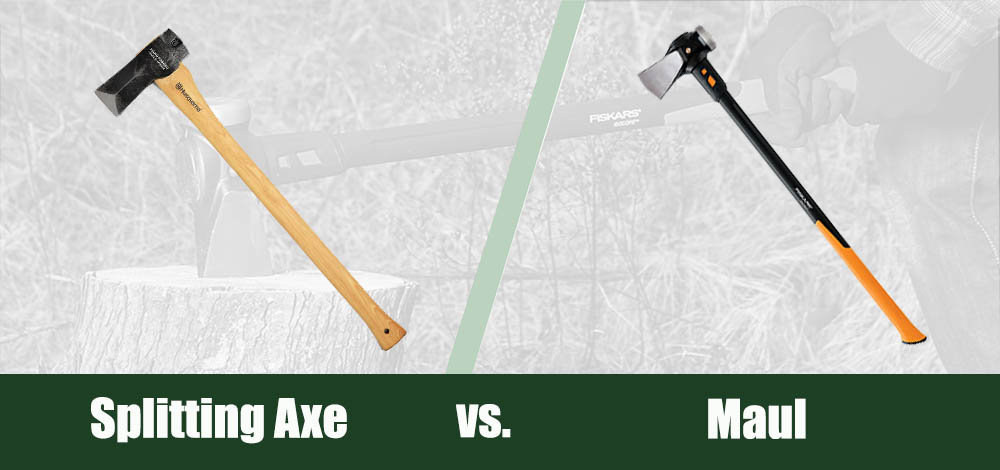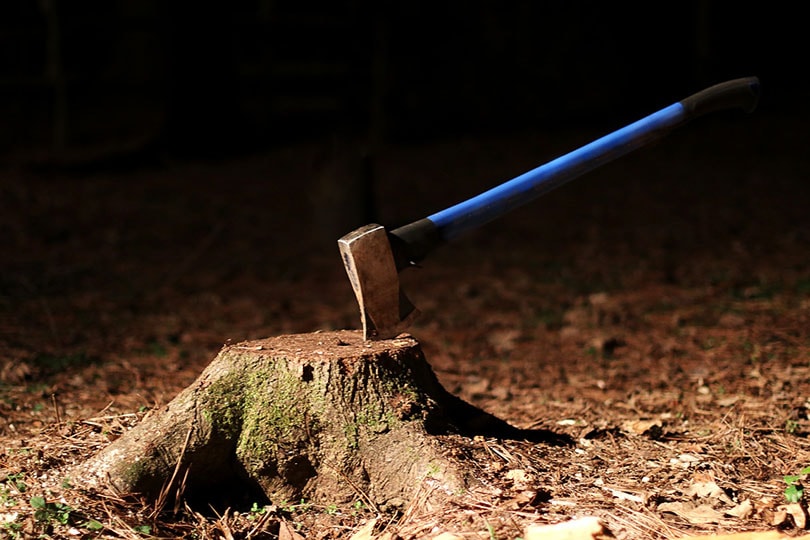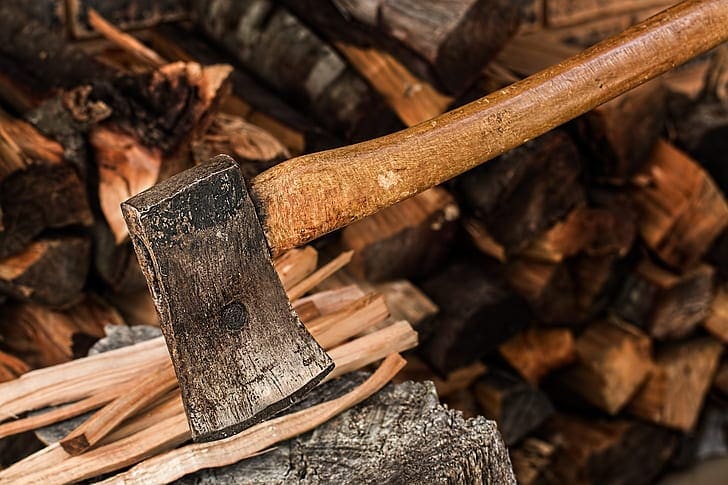Splitting Axe vs Maul: Which Should You Choose?
-
- Last updated:


You might be thinking about stockpiling split wood for the fires that will warm your home or magical bonfires on your local beach. You need to split logs for firewood, but which tool do you use? Since splitting logs is not everybody’s idea of fun, your first inclination might be to use a chainsaw. Most homeowner chainsaws are good for pruning tree branches and clearing brush but can’t handle the rigors of cutting large logs, much less splitting them. No, this job requires a hand tool and plenty of sweat.
As your search begins for the tool that simplifies splitting logs, you’ll see you have a few choices. In this article, we’ll look at two of them: the splitting axe and the maul.

Splitting Axe Overview
How It Works
Using a splitting axe involves placing the piece of wood you desire to split, sometimes referred to as the ‘round,’ on a flat, solid surface. The round should be standing on one of the ends. Make sure it is as close to perpendicular as possible for the best chance of splitting the wood evenly.
Using the axe has two steps:
1. Grip the handle of the axe with two hands.
2. Raise the axe overhead and strike down at the end of the round.
The wedge will penetrate the round to begin the split. Sometimes, because of the narrow wedge, it may become stuck in the round. Be careful when removing it. Typically, several strikes are needed in the same vicinity as previous strikes to complete the split.

The splitting axe is used to split logs or cut logs by chipping away at them. When chipping the wood, you get many small pieces that are usually cutting across the grain of the wood, while splitting wood is cutting with the grain of the wood. Many campers use an axe to chip and split wood for their fire. So, what makes the splitting axe an effective tool to use?
Design
The head of the splitting axe has a sharp wedge that makes it a good cutting tool. The head is relatively flat and only weighs between 3 to 6 pounds. Since the head is lightweight, the axe can be used for longer periods and make more accurate strikes.
Handling
Splitting axes come with a wooden handle, but for durability reasons, composite handles are an alternative. Remember, the handle you choose for your axe will add weight. Since the axe handle is shorter, you do not have the same leverage as you would with a longer-handled tool. Less leverage means you may take more swings to split a log.
- Shorter handle
- Lighter weight
- Sharper, narrower wedge
- More accurate strikes
- Can get stuck in the round
- Commonly used for chipping rather than splitting
- More force needed to execute the split
- More strikes needed to complete the split

Splitting Maul Overview
How It Works
The splitting maul is used the same way as the splitting axe. A round is placed on a flat, solid surface. Because of its weight, the maul must be firmly gripped with two hands as it is raised overhead and swung back down onto the end of the round. Because of the maul’s longer handle and its wedge’s additional weight, the round may split with one strike.
If not, additional strikes are necessary. You will notice that the blunt edge of the maul’s wedge does not penetrate as deeply as the wedge of the axe, but needless to say, the maul’s force drives through the round to cause it to split.

Design
The splitting maul is used for splitting wood. In most cases, the head of the maul is made of steel and is shaped like a cone with a wedge at one end. It is much larger than the splitting axe and is also much wider, which helps split the wood better. The wedge of the maul is not as sharp as the axe, but with the weight of the metal and the force of the swing, the wedge is driven into the wood to split it. Because of its blunt wedge, it has less of a tendency to get stuck.
Handling
The handle of the maul is longer than the axe, so the leverage is greater and the head of the maul strikes the round more perpendicularly, allowing the maul to go directly toward the ground. This decreases the chance of getting injured. Wood, fiberglass, and other composite handles are available.
Remember that because the maul is heavier, it requires greater strength and force to pick it up and swing it. Swinging the maul can tire you out more rapidly and cause injuries if you’re not careful.
- Made for splitting rounds
- Wider wedge to prevent getting stuck in the round
- Greater leverage
- Higher velocity
- Less accurate
- Heavier wedge
- More difficult to swing
- One tires more easily while using it
- See Also: 10 Best Wood Splitting Mauls
Using the Splitting Tools
When using either of the splitting tools, wear protective eyewear and have plenty of room to swing your axe or maul. Be sure to keep others away from the area where you are working. Stand the round on an end and look for a possible crack in the wood.
When swinging the tools, strike the round as near the crack as possible. In the beginning, you may find your aim with the axe is a little better because it is lighter and easier to control. However, one well-placed swing of your maul will split a log immediately.
Similarities & Differences
The splitting axe and splitting maul share only a few differences between them. The axe is smaller and easier to handle for a longer period. The maul, on the other hand, is heavier and requires more strength to swing. Each will split your wood, but the time and effort will vary depending on the tool you choose.
The determining factor for which tool to use may be decided by the task you are undertaking. A few simple rounds to split can easily be handled with a splitting maul, but cutting a stockpile of split rounds may be better suited for the lighter, easier-to-handle splitting axe.
Which Should You Choose?
A few factors to consider when making your choice.
- Your overall physical ability. No one knows you better than yourself. How much stamina and strength do you have?
- The size of the job. For a smaller job, a maul can make quick work of it. For a larger job, an axe may be easier to handle for the duration.
- The type of job. When Splitting rounds, a maul is appropriate. If you’re chopping wood, an axe is the best tool to use.
- The weight and size of the tool you are willing to use. The splitting axe is lighter and smaller, and the splitting maul is larger and heavier.

Conclusion
Choosing between the splitting axe vs. the maul depends on your preference and the tool you feel most comfortable with. Using a tool you are not capable or confident in using is never a good idea. Making a wise decision requires having an understanding of the tasks at hand. Assess the job, know your ability, and compare the axe’s and maul’s attributes. The axe is better when cutting several logs because it’s lighter, but the maul is ideal when you need to split a few logs for firewood.
Featured Image Credit: Pikrepo
Contents

